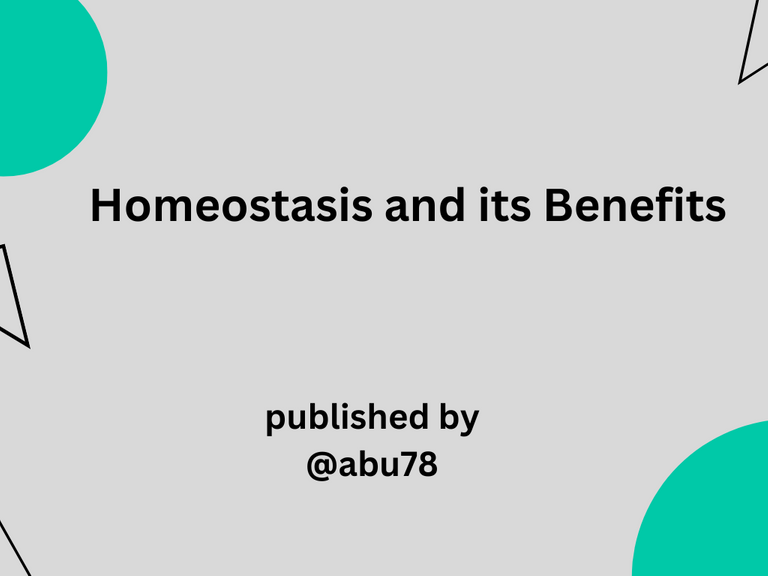Homeostasis and the benefits
Greetings to all and sundry on this platform once again. As a biochemistry student, I researched "Homeostasis and its benefits" today and decided to share it with you guys here. I hope that you will enjoy it and also learn from it. Stay tuned with me as I discuss this topic in my article.

Homeostasis is a condition in which the internal environment of an organism is at a steady state despite the changes in the external environment. A good example is the maintenance of good glucose levels and also the temperature of the human body. It also involves the steady state of the physical and chemical conditions of an organism.
Generally, homeostasis can be obtained via either a positive or negative feedback mechanism. These negative or positive feedback mechanisms have certain or specific activities they control. The positive feedback mechanism occurs in blood clotting and also during childbirth which helps by increasing the original stimulus to send the variable farther. On the other hand, negative feedback mechanisms involve the shutting down of the original stimulus or decreasing the intensity of a stimulus. This type of feedback operates like a thermostat and they include most homeostatic mechanisms. Examples include temperature regulation, blood sugar level regulation, and the regulation of blood pressure.
In a homeostatic system, there are three important components and they are;
a sensor that detects or identifies the stress, the control center which is responsible for receiving the information from the sensor, and the effector which is responsible for receiving the information from the control center and then produces a response that would help to re-establish homeostasis of that organism.
Let's look at the Homeostatic Regulation of Body Temperature via the negative feedback mechanism.
When the body gets too hot or cold, sensors that can be found in the brain and periphery stimulate the temperature regulation center of the brain found in the hypothalamus that the body temperature has moved from its normal state.
When it is that your body temperature has raised, then the blood vessels would expand which would lead to the loss of heat to the surroundings. The sweat gland would start to secrete fluids, and as these fluids are being excreted, the body loses heat to the environment in the process.
On the other hand, when your temperature is cold or falls, then the blood vessels would contract which would lead to the conservation of heat in the body. The sweat gland would not secrete fluids as in the case of the first scenario. Here, involuntary contraction of the muscles such as shivering would generate heat to warm the body.
Now, we would look at the homeostatic regulation of blood sugar levels through the negative feedback mechanism. In this condition, the mechanism is regulated by two hormones which are insulin and glucagon. First of all, let's look at the case of insulin.
Insulin is used to decrease blood glucose concentration. When there is a rise in the blood glucose level, it triggers the secretion of insulin from the Beta cells of the pancreas, which tend to trigger other cells such as muscle cells, adipose tissues, and red or white blood cells, to utilize glucose as fuel or energy. The secreted insulin also causes the conversion of glucose into glycogen through the process termed glycogenolysis. These processes decrease the blood sugar level thereby bringing the system back to homeostasis.
On the hand, glucagon acts in the opposite that of insulin. Here, when there is a decrease in the glucose level of an organism, it triggers the release of glucagon to increase the concentration of glucose in the blood. Glucagon reacts with the liver to cause the breakage of stored glycogen back to glucose which is released into the bloodstream. This results in the rise of sugar levels in the blood thereby bringing back the system to homeostasis.
Homeostasis helps to regulate fluids, ions, and other important substances in the body of organisms. It also helps to maintain constant internal conditions during situations where there is a change in external conditions. Homeostasis helps to maintain an accurate condition for cells and enzymes to function.
The references given below are sites where you can learn more about homeostasis.
Reference 1
Reference 2
Reference 3
Reference 4

This is very essential in the sense that when excess metabolism of these ions is found in the body it can many implications, the body need detoxification of excess ion.
Thanks for stopping by, I do appreciate your comment
Congratulations @abu78! You have completed the following achievement on the Hive blockchain And have been rewarded with New badge(s)
Your next target is to reach 20000 upvotes.
You can view your badges on your board and compare yourself to others in the Ranking
If you no longer want to receive notifications, reply to this comment with the word
STOPCheck out our last posts:
Support the HiveBuzz project. Vote for our proposal!
Thanks for sharing. I didn’t know this😁
It's good now you know.
Thanks for your contribution to the STEMsocial community. Feel free to join us on discord to get to know the rest of us!
Please consider delegating to the @stemsocial account (85% of the curation rewards are returned).
Thanks for including @stemsocial as a beneficiary, which gives you stronger support.